There are 42 snakes you may encounter in South Carolina.
Are you wondering if the snake in your yard is venomous or what snake you saw today? Continue reading to help you identify the snakes you may come across in South Carolina.
Table of Contents
1. Eastern Copperhead
Scientific name: Agkistrodon contortrix.
Common name: eastern copperhead, copperhead.
Length: 20–37 in (51 – 94 cm)
Venomous: Yes.
Copperheads are venomous and large snakes, growing up to 37 inches.

They are heavy-bodied with triangular heads and cat eyes. The body is tan to brown in color with dark hourglass-shaped crossbands all the way down the body. The head is solid brown with two dots on the top of the head.
The juveniles look the same as adults, except they have bright yellow on the tip of their tail, which fades as they age.
The males are larger than females.
Copperhead snakes are most common in the forest areas throughout South Carolina.
Even though they are venomous, fatalities are very rare.
Further Reading:
2. Cottonmouth
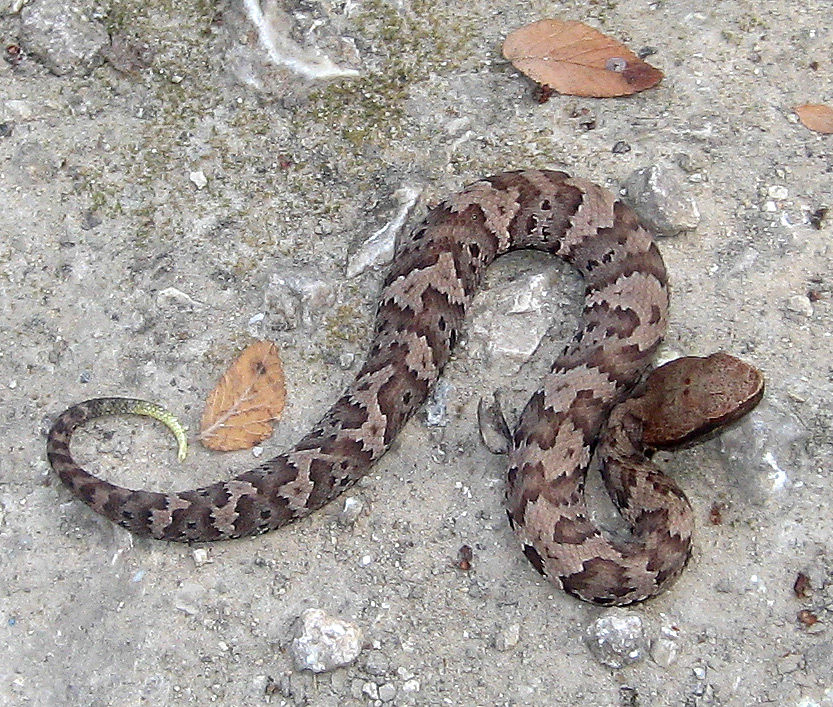
Scientific name: Agkistrodon piscivorus.
Common name: cottonmouth, water moccasin, swamp moccasin, black moccasin, viper.
Length: 30 – 48 in (76-122 cm)
Venomous: Yes.
Cottonmouths are venomous snakes, that are also semi-aquatic, sometimes called water moccasins.
They are large and can grow up to 48 inches with large triangular heads and large jowls.
There is a dark line through the eye. The colors can vary and some have beautiful dark crossbands on brown and yellow, while others are plain black or brown. The older the snake, the more solid the color appears.
They have a dark belly with brown to yellow patches and the underside of the tail is black.
They can often be found around drying pools in the wetlands, where they feed on the trapped amphibians and fish.
They can be seen throughout the year and on sunny days, they will be basking on rocks and logs along the edge of the water.
Unlike non-venomous water snakes, the cottonmouth will not flee if approached but will stand its ground. Cottonmouth bites are not that common unless they are picked up or accidentally stepped on.
3. Eastern Diamondback Rattlesnake

Scientific name: Crotalus adamanteus.
Common name: eastern diamondback rattlesnake.
Length: 33 – 72 in (84 – 183 cm)
Venomous: Yes.
Eastern diamondback rattlesnakes are venomous and the largest of the 32 recognized rattlesnake species.
They are heavy bodies and large snakes with broad heads that have two lines on the face.
Adults can grow to around 72 inches, though one individual has been recorded at 96 inches (244cm).
They are tan, brown, or yellow with brown diamonds, which are surrounded by lighter-colored scales.
They live in dry sandy areas, flat woods, and pine woods, along with coastal dunes. While they do avoid wet areas, they can sometimes be observed on the edge of swamps, where they are very accomplished swimmers.
4. Timber Rattlesnake

Scientific name: Crotalus horridus.
Common name: timber rattlesnake, canebrake rattlesnake, banded rattlesnake.
Length: 30 – 60 in (76 – 152 cm)
Venomous: Yes.
The timber or canebrake rattlesnake is a large snake with rattles on the end of the tail.
This heavy-bodied snake can grow up to 60 inches in length.
Canebrake rattlesnakes as they are known in the Coastal Plain of the Southeast are usually gray with a pink, yellow, orange, or brown stripe that runs down the back.
Timber rattlesnakes are usually more yellow or brown with some being black. Both have a solid black tail and black chevrons can be found on the back and sides which point to a V facing forward.
They can be observed in a range of habitats including swamps, floodplains, pine forests, mountains, and rural habitats.
The majority of these snakes, even though considerably large, are not aggressive, even if you encounter them in their natural habitats.
Often they will simply not move, but if threatened, they can give a serious bite, which will require immediate and urgent medical attention.
5. Pigmy Rattlesnake
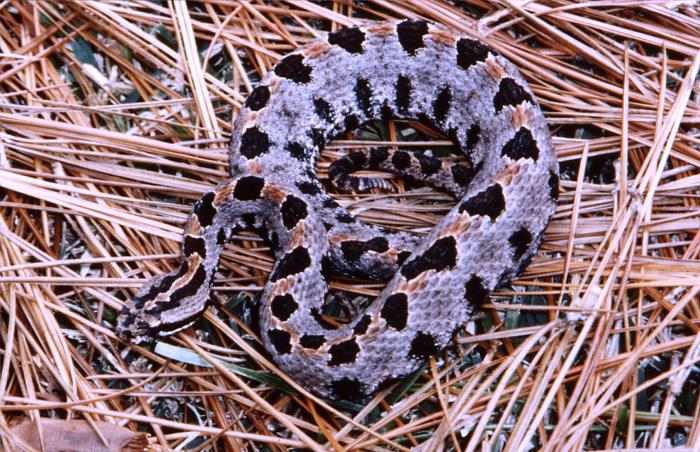
Scientific name: Sistrurus miliarius.
Common name: pygmy rattlesnake.
Length: 14 – 22 in (38 – 56 cm)
Venomous: Yes.
These are small rattlesnakes that grow to around 22 inches.
They have nine large scales on the top of their heads and a tiny rattle you can barely hear. They have spots mid-dorsal with a bar that runs from the eye to the mouth. The bar can vary from red to brown to black.
They have orange or red-brown dorsal stripes with younger snakes having yellow at the tip of their tail, which fades as they age.
The pigmy rattlesnake in South Carolina prefers drier habitats, such as pine forests and sandhills.
6. Eastern Coralsnake

Scientific name: Micrurus fulvius.
Common name: eastern coral snake, common coral snake, American cobra.
Length: 18 – 30 in (46 – 76 cm)
Venomous: Yes.
The venomous coral snake is a medium and slender snake, growing up to 30 inches in length with smooth scales.
Their body is a beautiful pattern of red, black, and yellow rings with a black nose.
They are often seen in pine and scrub oak sandhills, along with hardwoods and pine flat woods. They are rarely seen and spend most of their time underground.
They are mostly seen in the spring and fall.
Further Reading:
7. Worm Snake

Scientific name: Carphophis amoenus.
Common name: worm snake.
Length: up to 13 in (33.5 cm)
Venomous: No.
Worm snakes are small 13 inches snakes that are brown in color with shiny and smooth scales. The body is dark to light brown on top and white to pink on the bottom.
These snakes can be found in the mountains and Coastal Plain in South Carolina.
They prefer forested habitats and are common in woodlands or forests near wetlands and swamps. They are often found under leaf litter, rocks, and logs.
They are ground dwellers and will flee when encountered. They are completely harmless to humans.
8. Scarlet Snake

Scientific name: Cemophora coccinea.
Common name: scarlet snake.
Length: around 20 in (51 cm)
Venomous: No.
Scarlet snakes are small and slender snakes, growing to around 20 inches in length.
They have patterns that alternate yellow, black, white, and red. They have a pointed snout with their red bands being wider than the other colors, which can help you differentiate them against the venomous coral snake.
These snakes are found throughout the Coastal Plain and all mountainous areas in northwestern South Carolina. They can be observed in scrub habitats and pine forests.
They spend the majority of their time underground, sometimes hiding under logs and rocks.
9. Eastern Racer
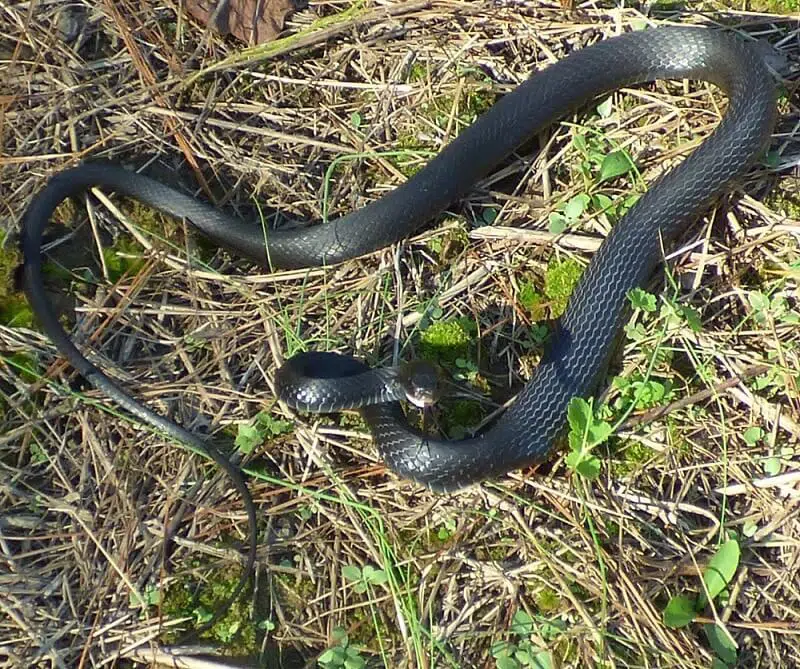
Scientific name: Coluber constrictor.
Common name: Eastern racer.
Length: up to 60 in (152 cm)
Venomous: No.
Eastern racers are large, slender, solid black snakes that can grow up to 60 inches in length.
They have large eyes with white under the chin and smooth scales. The belly is black or dark gray.
These snakes will flee if approached and will very rarely stand their ground.
Younger snakes are tan or gray with brown to red patches down the middle of their backs, their patterns and colors turn black when they reach around 12 inches.
They are common in South Carolina where they can be found in old fields, wetland edges, agricultural habitats, and the edges of forests.
They are agile and fast and will flee if approached.
10. Ringneck Snake
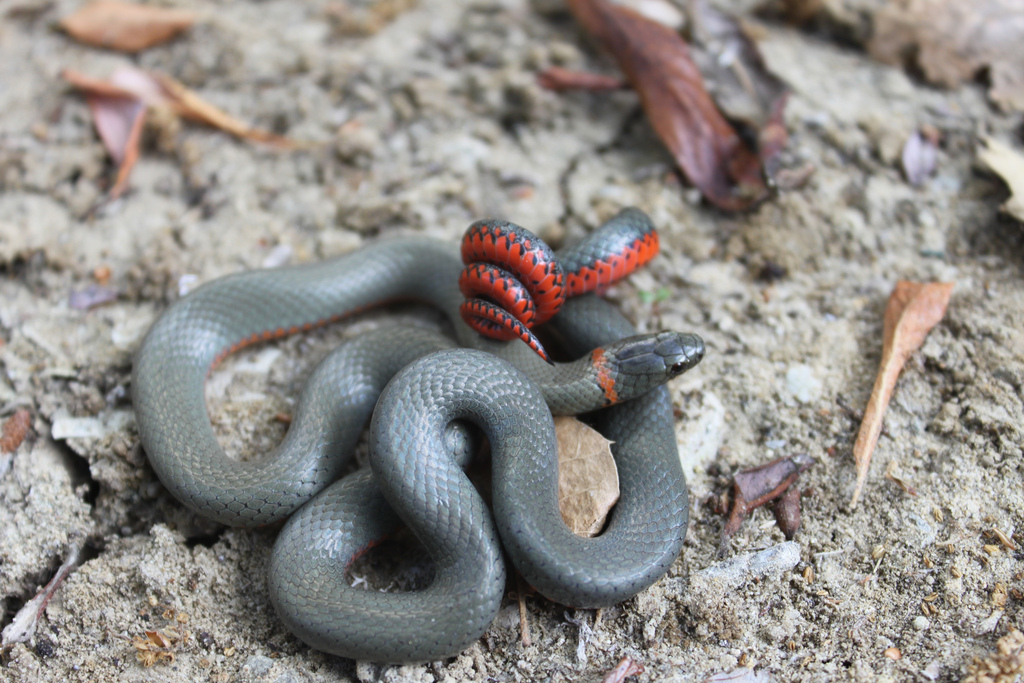
Scientific name: Diadophis punctatus.
Common name: ringneck snake.
Length: 10 – 15 in (25 – 38 cm)
Venomous: No.
Ringnecks are small and slender snakes, growing up to 15 inches (38cm).
They are gray in color with an orange or yellow band around their neck and underside.
There are two subspecies found in South Carolina, one prefers mountainous areas and has a complete ring around the neck with no pattern on the underside, where the other prefers the Coastal Plain and has a broken neck ring and black spots on the underside.
Both are tan to black in color with females being larger than the male.
11. Eastern Indigo Snake

Scientific name: Drymarchon couperi.
Common name: eastern indigo snake.
Length: 60 – 82 in (152 – 213 cm)
Venomous: No.
The Eastern indigo snake is a large black snake that is the longest snake native to the US.
It can grow up to 84 inches and is black to blue in color, which includes the belly. The sides of the head and chin have orange-brown to red coloration.
Juveniles look like adults but have more red on the head.
Eastern indigo snakes can be found in southern South Carolina. They forage along wetland margins and are active during the day.
They are not dangerous to humans but may hiss and vibrate their tails if you corner them.
12. Corn Snake

Scientific name: Pantherophis guttatus.
Common name: corn snake.
Length: 30 – 48 in (76 – 122 cm)
Venomous: No.
Corn snakes are large 48 inches snakes that are slender in build.
They are orange, red-brown, gray, or brown in color with square black margined red or brown blotches. They have a checkered belly that is done in black and white. There is also a spear-shaped mark on the top of the head, which points in the direction of the nose.
They are common in the Coastal Plain where they prefer sandy habitats. They can also be found in agricultural and suburban areas.
It’s not uncommon to encounter a corn snake in an old barn or deserted house, where they hunt for mice and rats.
Further Reading:
13. Eastern Ratsnake

Scientific name: Pantherophis alleghaniensis.
Common name: eastern ratsnake.
Length: 36 – 72 in (90 – 180 cm)
Venomous: No.
An adult rat snake can grow up to 72 inches in length.
They are large and vary in appearance depending on their geographical range.
The black rat snakes are from the northern distribution and are black on the upper half with white in between the scales.
The yellow rat snakes are yellow, orange, or green with four stripes that run the length of the body and gray rat snakes are light to dark gray with brown to gray patches.
Black and yellow rat snakes can be found in South Carolina where they live in hardwood forests, swamp margins, and river floodplains. They are often encountered in abandoned buildings.
14. Mud Snake

Scientific name: Farancia abacura.
Common name: mud snake.
Length: up to 81 in (207 cm)
Venomous: No.
Mud snakes are large non-venomous aquatic snakes that are very seldom observed, as they are so secretive.
They can grow up to 81 inches and are heavy bodies with black on their backs.
Their belly is black and red or pink checkerboards with some yellow on the head. They have smooth scales with a spine-like scale on their tail, which is why they are sometimes called horn snakes.
They are sometimes encountered in aquatic habitats such as bays, swamps, marshes, slow-moving streams, lakes, ponds, and wetlands.
The young mud snake often lives in a seasonal wetland as a juvenile and moves to a permanent water source as it gets older.
15. Rainbow Snake
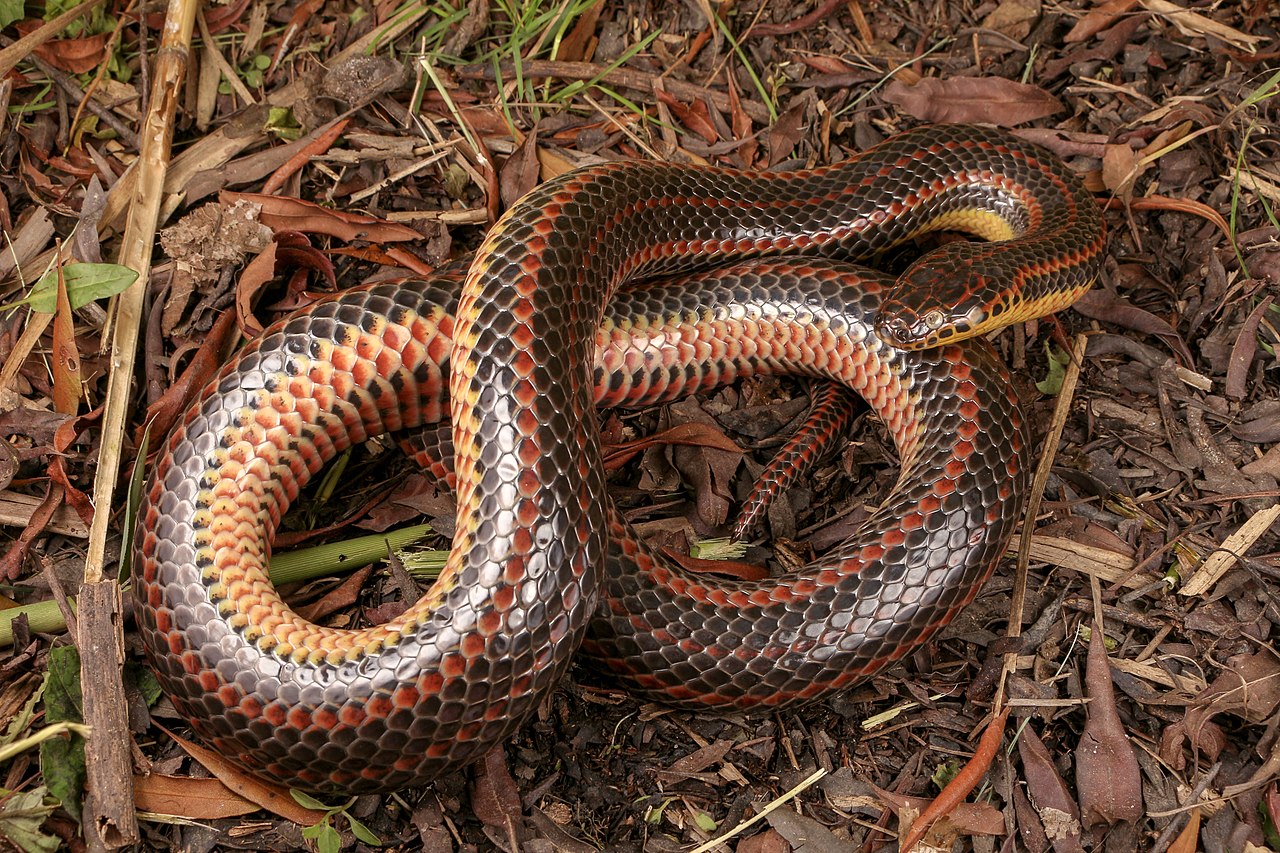
Scientific name: Farancia erytrogramma.
Common name: Rainbow snake.
Length: up to 66 in (168 cm)
Venomous: No.
Rainbow snakes are large non-venomous snakes that can grow up to 66 inches in length.
They are highly aquatic and are seldom seen.
They are beautiful snakes with three red stripes that run down their backs. The base color is a glossy back with a red or pink belly with black spots and color on the sides and the head.
They can be found in a range of aquatic habitats including tidal or brackish water.
They are harmless and will not bite.
16. Eastern Hognose Snake
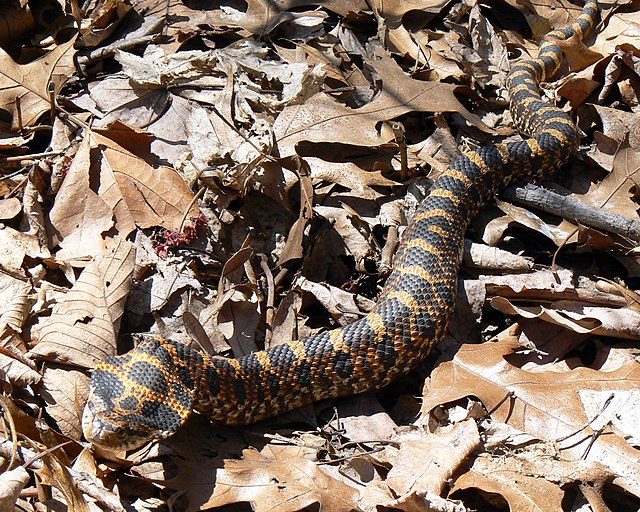
Scientific name: Heterodon platirhinos.
Common name: eastern hognose snake, spreading adder, deaf adder.
Length: around 46 in (115 cm)
Venomous: No.
These snakes, sometimes referred to as “puff adders”, are thick-bodied snakes that can grow up to 46 inches in length.
They are variable in color but have an upturned snout, which helps with identification. They can be gray, green, black, or gray in color with large rectangular markings down the center of the back.
They will suck in the air if confronted and spread the skin around their neck and head while hissing and pretending to strike.
Sometimes they will play dead, they will almost never bite.
They can be encountered throughout South Carolina in woodlands, farmland, and coastal areas.
17. Southern Hognose Snake
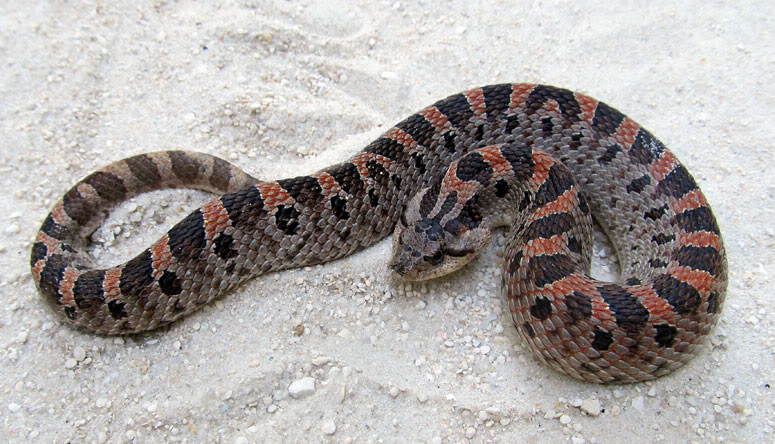
Scientific name: Heterodon simus.
Common name: southern hognose snake.
Length: around 24 in (61 cm)
Venomous: No.
The southern hognose is a small snake with a heavy body that can grow up to 24 inches in length.
They have upturned snouts, which are pointed and are gray, tan, or red with dark brown patches down the center of the back and smaller patches on the sides.
They are found in scattered locations in South Carolina where they live in pine flat woods, coastal dunes, and sandhills.
These harmless snakes may put on a defensive display before they play dead.
18. Prairie Kingsnake

Scientific name: Lampropeltis calligaster.
Common name: prairie kingsnake, yellow-bellied kingsnake.
Length: 30 – 40 in (76 – 101 cm)
Venomous: No.
The prairie kingsnake is very seldom observed. They grow up to 40 inches and have smooth scales and light brown to red-colored bodies with red to brown spots down the length of their dorsum, which fades with age.
It is mostly seen in the Coastal Plain in South Carolina but can be found in open habitats, including fields, thickets, and cultivated land.
19. Eastern Kingsnake
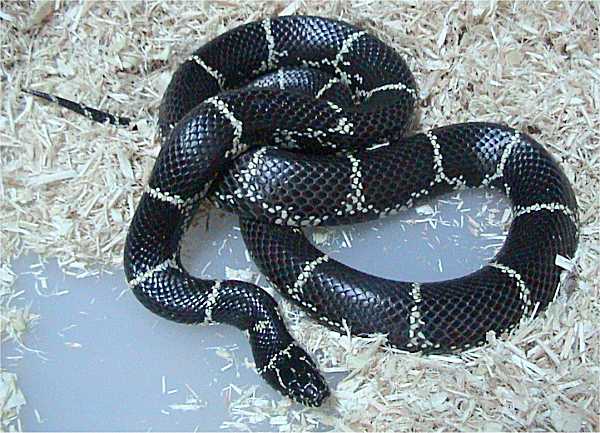
Scientific name: Lampropeltis getula.
Common name: eastern kingsnake, common kingsnake, chain kingsnake.
Length: 36 – 48 in (90 – 122 cm)
Venomous: No.
The Eastern kingsnake is a large smooth scaled snake that is shiny black, growing up to 48 inches.
They have white to yellow chain-linked bands across the back, connecting on the sides, which is why some people refer to them as chain kingsnakes.
The Eastern kingsnake from the Coastal Plain has wide bands and those from mountainous regions have thin bands, sometimes almost completely black in color.
They can be encountered throughout South Carolina where they prefer areas close to water.
They are secretive and can be found under objects.
20. Scarlet Kingsnake

Scientific name: Lampropeltis elapsoides.
Common name: scarlet kingsnake, scarlet milk snake.
Length: 16 – 20 in (40 – 50 cm)
Venomous: No.
Scarlet kingsnakes are smaller than the milk snake, growing to 20 inches in length with beautiful coloration. They have alternating bands of yellow, black, and red where the red touches the black but does not touch the yellow bands.
Milksnakes are mid-sized snakes growing to 35 inches and have a Y shape on the base of the head. They are tan to gray with black-bordered brown patches on the base of the dorsum. They have a black and white checked pattern on the belly.
It’s not uncommon for the milksnake to be confused with the venomous copperhead, except copperheads have an hourglass shape, rather than square or rounded patches.
The milk snake is restricted to the mountainous areas in northwest South Carolina, while the scarlet kingsnake is found in the sandy habitats of the Coastal Plain.
Milksnakes are commonly found in barns, hiding under rocks and boards, while the scarlet kingsnake prefers to live underground.
21. Coachwhip
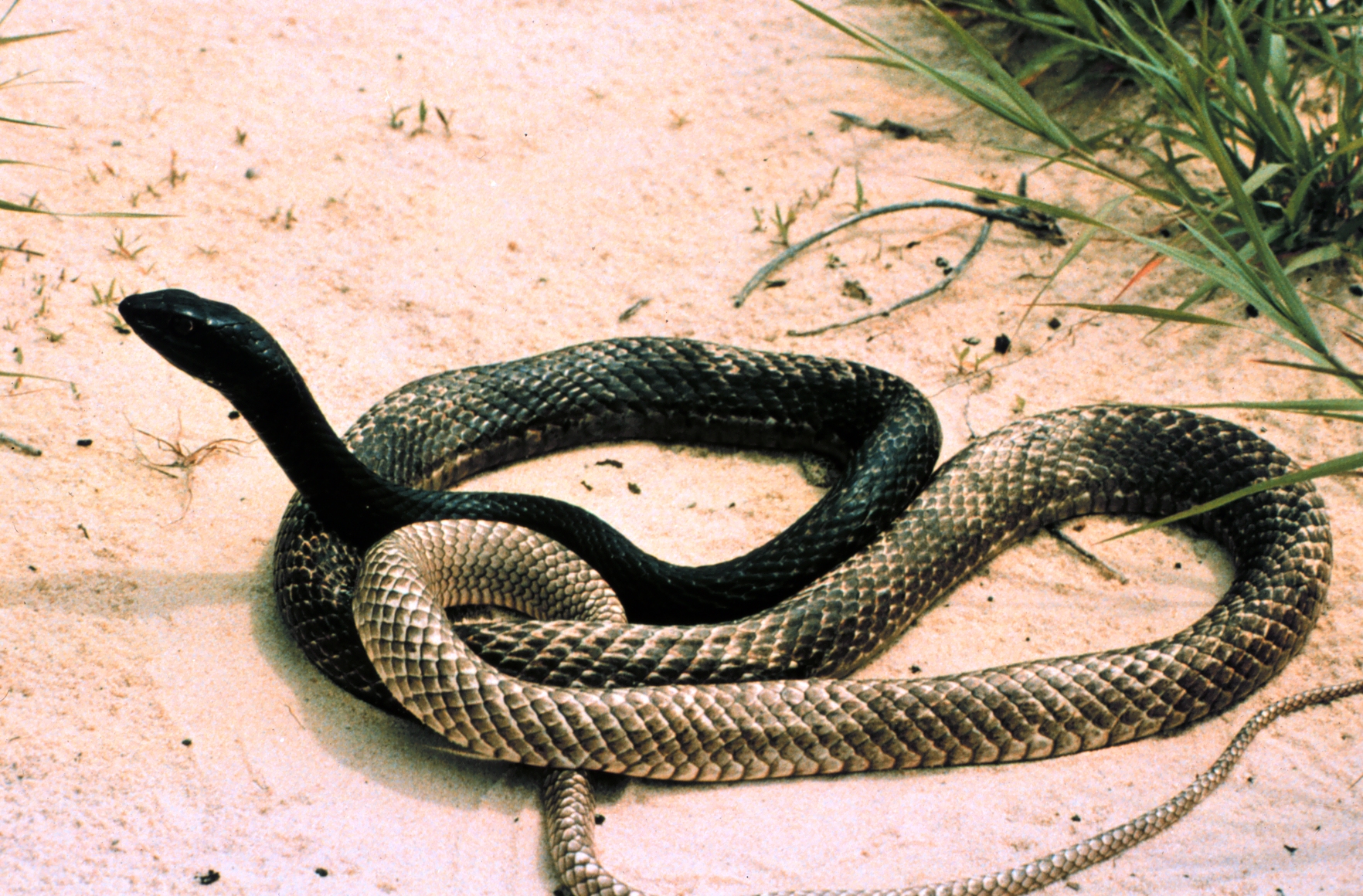
Scientific name: Masticophis flagellum.
Common name: coachwhip, whip snake.
Length: 24 – 40 in (76 – 122 cm)
Venomous: No.
Coachwhips are among the longest snakes in South Carolina, this slender snake can reach lengths of more than 40 inches.
They have distinctive coloring which fades from black on the head to tan on the body and almost white by the time it reaches the tail, some are completely tan.
The scales on the tail have a pattern that looks like a braided whip.
They can be encountered in the mountainous areas of northwest South Carolina and throughout the Coastal Plain. They prefer sandhills and coastal areas.
If captured, they will bite, though some may hide their heads or go limp if captured.
22. Plain-bellied Water Snake

Scientific name: Nerodia erythrogaster.
Common name: plain-bellied water snake.
Length: around 48 in (122 cm)
Venomous: No.
Plain-bellied water snakes are large snakes growing to 48 inches (122cm). They are semi-aquatic and are dark brown, gray, or light brown in color with orange to yellow belly. Females are larger than the male.
They can be observed throughout the Coastal Plain where they are found near lakes, rivers, swamps, and most commonly seen basking near the water source, soaking up the sun.
Unlike other water snakes, the plain-bellied water snake will flee when approached, but they do not head for the water, but rather head onto land to escape.
23. Banded Water Snake

Scientific name: Nerodia fasciata.
Common name: banded water snake, southern water snake.
Length: 24 – 42 in (61 – 107 cm)
Venomous: No.
Banded water snakes are mid-sized snakes with heavy bodies, they are semi-aquatic and can grow up to 42 inches in length.
Their color can vary from light brown to black or red with dark crossbands. The crossbands are wider on the center of the back and narrow as it reaches the sides.
These snakes get darker as they age, which means the crossbands may not be as visible.
They have square spots on the side of the belly and a dark stripe that runs from the jaw to the eye.
They can be observed near freshwater, which includes lakes, rivers, swamps, marshes, streams, and ponds.
24. Green Water Snake
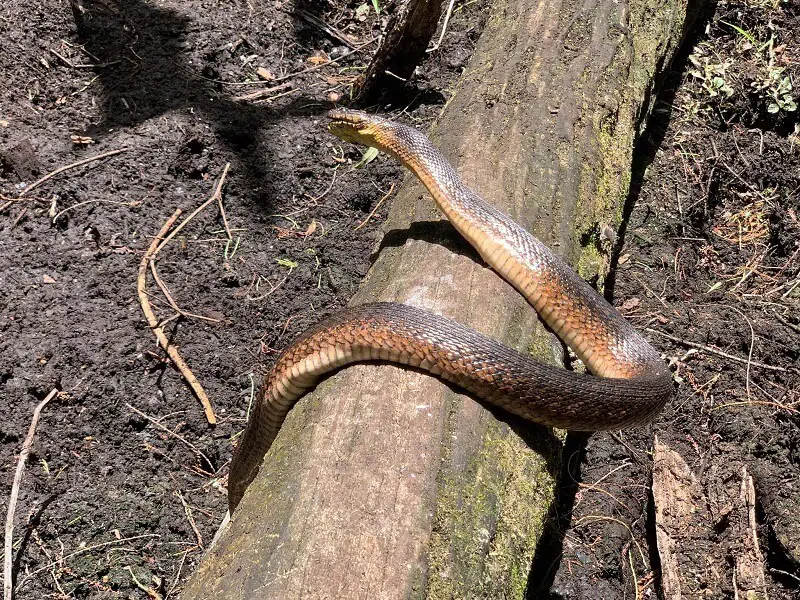
Scientific name: Nerodia floridana.
Common name: Florida Green Watersnake, Eastern Green Watersnake.
Length: 30 – 55 in (76 – 140 cm)
Venomous: No.
Green water snakes are the largest water snake you will encounter in North America and can grow up to 55 inches in length.
The younger snakes have dark bars down their dorsum and their sides, which fade with age.
Females tend to be larger than the male.
They can be found in western and southern Carolina, where there are two isolated populations. They prefer areas such as marshes and swamps but are sometimes seen in ponds, slow rivers, lakes, ditches, and brackish water sources.
While they are not venomous, they will bite if captured.
25. Northern Water Snake

Scientific name: Nerodia sipedon.
Common name: banded water snake, black water adder, black water snake, brown water snake, common water snake, common northern water snake, eastern water snake, North American water snake, northern banded water snake, northern water snake, spotted water snake, streaked snake, water pilot.
Length: 24 – 55 in (61 – 140 cm)
Venomous: No.
Northern water snakes can grow up to 55 inches and are dark in color, which can range from brown to gray or tan. They have square patches on their back and sides.
They are often mistaken as the venomous cottonmouth, except that the cottonmouth has bands not patches. Cottonmouths are also restricted to the Coastal Plains.
They live in a variety of aquatic habitats, including marshes, streams, rivers, ponds, and lakes. You may encounter one as it basks in the sun on a branch that hangs over the water.
If approached, the snake drops into the water to escape.
26. Brown Water Snake
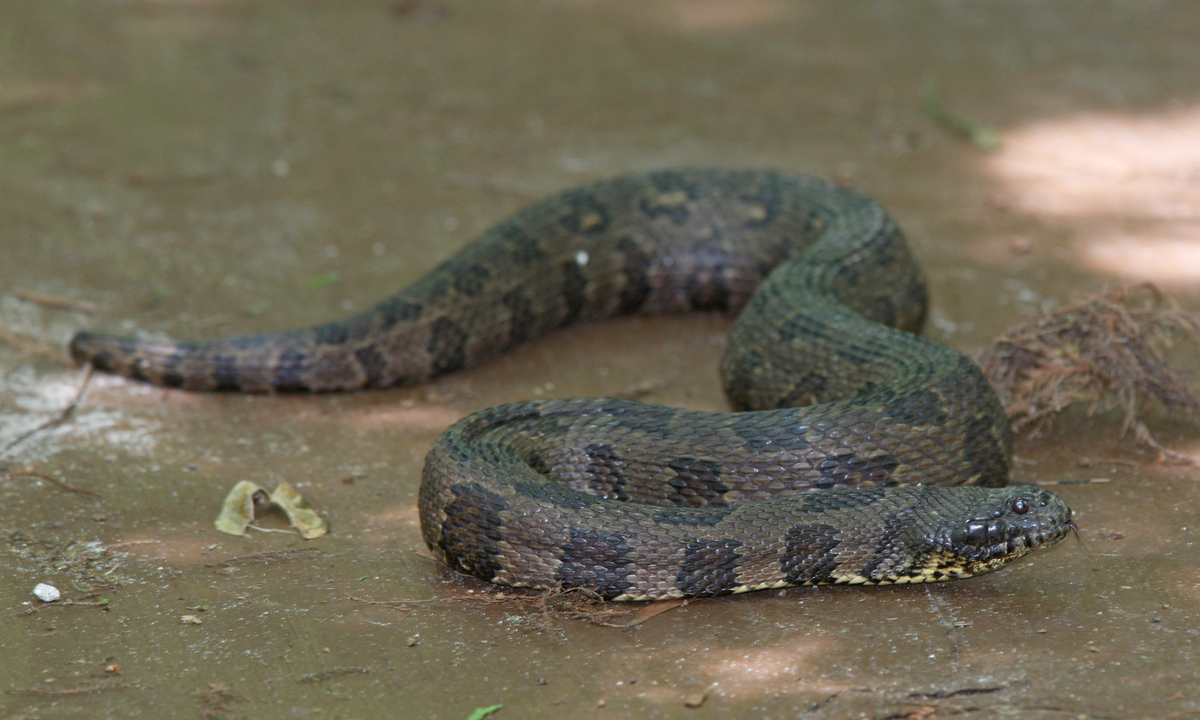
Scientific name: Nerodia taxispilota.
Common name: brown water snake.
Length: 30 – 60 in (76 – 152 cm)
Venomous: No.
Brown water snakes are large heavy-bodied semi-aquatic snakes that grow up to 60 inches.
They are light to dark brown and have dark brown square patches that run down the center of the dorsum with two lines that run in alternating arrows down the side of the body. They have a light-colored belly with brown patches and black crescents.
They can be seen throughout South Carolina, except in mountainous areas of northwestern South Carolina.
These water snakes can be found in a range of aquatic habitats, but they prefer flowing water such as cypress creeks, rivers, and canals.
They will bite if cornered, which can be painful but is not considered dangerous or venomous.
27. Rough Green Snake
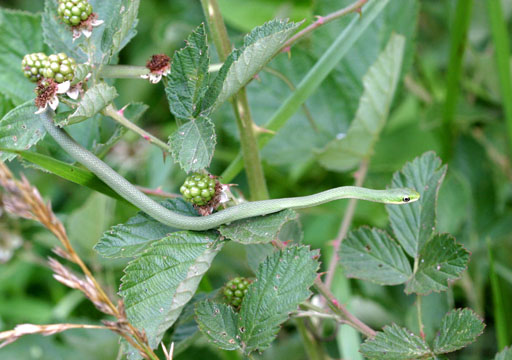
Scientific name: Opheodrys aestivus.
Common name: rough green snake, grass snake, green grass snake.
Length: 22 – 32 in
Venomous: No.
Rough green snakes are long and slender snakes that are bright green with white or yellow bellies.
They can grow up to 32 inches in length and are bright green, which helps you identify them in South Carolina.
They enjoy a wide variety of habitats but are often encountered in open forests, wetlands, and river edges.
They are tree-dwelling snakes and spend most of their time above the ground. They will freeze if encountered, trying to camouflage into their surroundings.
28. Pine Snake
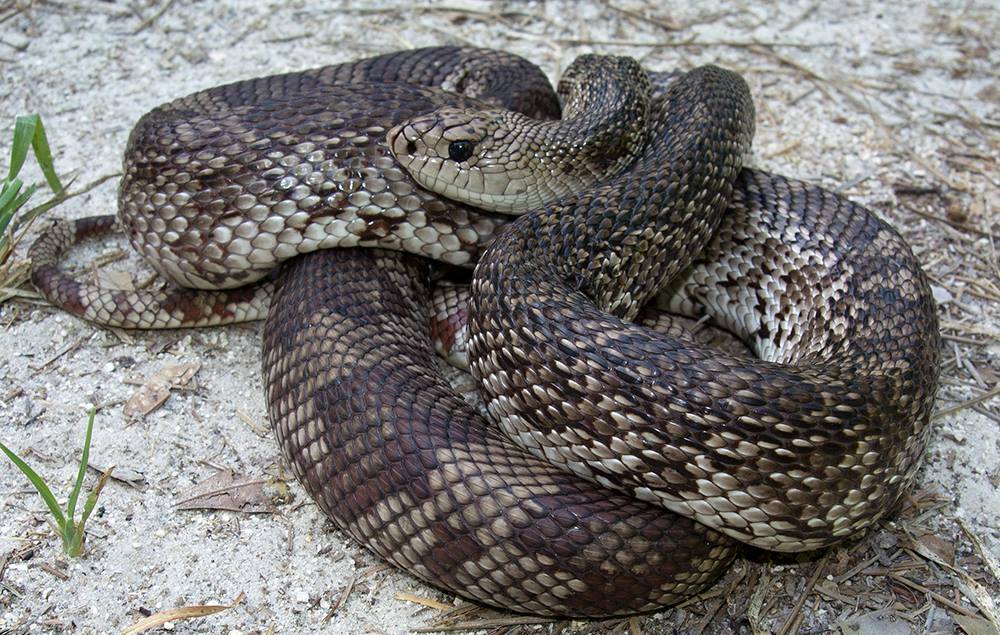
Scientific name: Pituophis melanoleucus.
Common name: pine snake.
Length: 48 – 66 in (122 – 168 cm)
Venomous: No.
The pine snake is a large heavy-bodied snake that can grow to 66 inches in length.
Their color can range from light gray to white or yellow with dark square patches on the back and side that lighten as they near the tail and darken as they near the head. Their belly is white and has some dark spots on the sides. Their heads are small with a pointed snout.
They are found throughout the Coastal Plain in South Carolina where they prefer sandhills and sandy pine habitats, though they are sometimes seen in oak forests, abandoned fields, and dry mountainous areas.
They are excellent at burrowing and spend the majority of their time underground, surfacing from May to October.
If approached, they will hiss, vibrate their tail and strike, but they are not venomous.
29. Striped Crayfish Snake
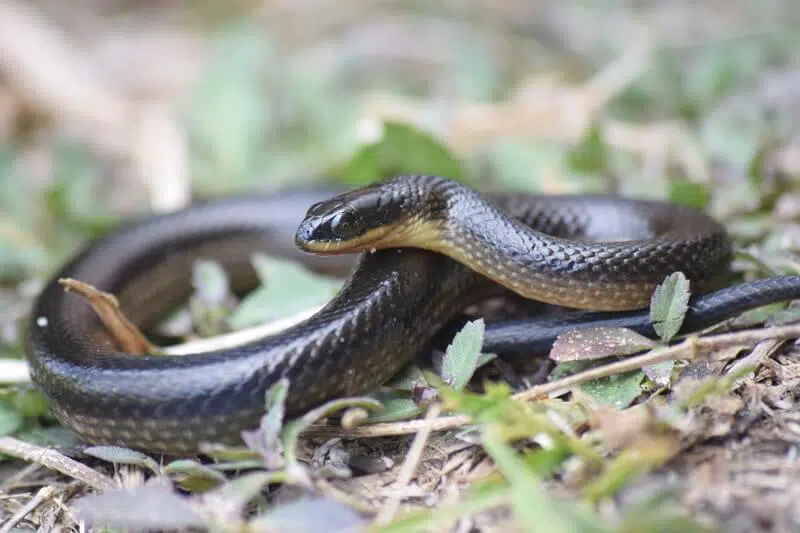
Scientific name: Regina alleni.
Common name: striped crayfish snake, Allen’s snake, striped swamp snake, striped swampsnake, swamp snake.
Length: 14 – 20 in (36 – 51 cm)
Venomous: No.
This medium-sized snake is highly aquatic and can grow up to 20 inches.
They have heavy bodies, large eyes, and short heads with a brown to green color that has three stripes that run the length of the body. Their belly is orange to yellow with dark spots down the center.
They live in aquatic habitats, which include saw grass prairies, sphagnum bogs, cypress stands, swamps, and ditches.
They are not observed often, due to their secretive nature. They may be seen crossing a road on a wet night.
30. Glossy Crayfish Snake

Scientific name: Regina rigida.
Common name: crayfish snake, glossy crayfish snake, glossy swampsnake, glossy water snake, striped water snake.
Length: 14 – 24 in (36 – 61 cm)
Venomous: No.
The glossy crayfish snake is a highly aquatic snake that is medium in size, growing to 24 inches.
They have large eyes, short heads, and heavy bodies that are a shiny olive to brown with two light stripes that run down the length of the body. They have a yellow belly which has two rows of dark spots and is very similar in appearance to the striped crayfish snake.
They are common in the Coastal Plain and being highly aquatic they prefer wetland habitats. They are not encountered very often, due to their secretive nature.
If captured, they will hiss and strike, but they seldom bite.
31. Queen Snake

Scientific name: Regina septemvittata.
Common name: queen snake.
Length: up to 24 in (61 cm)
Venomous: No.
The queen snake is a medium-sized slender snake that is common in flowing waters.
They grow to around 24 inches and are gray in color, though they can range from olive green to light brown with three dark stripes running down the body with two lighter stripes on the sides.
They have a yellow belly with four brown stripes, two down the center of the belly and one on either side.
They are commonly observed near running waters, such as rivers and streams, though they sometimes live in lakes.
32. Pine Woods Snake

Scientific name: Rhadinaea flavilata.
Common name: pine woods snake, yellow-lipped snake, brown-headed snake.
Length: 10 – 13 in (25 – 33 cm)
Venomous: No.
These are small snakes that grow up to 13 inches and are slender. They are mostly brown, though can range from a red to a golden brown color with a darker head. They have a dark stripe that goes through the eye with yellow scales on the upper lip.
They are found scattered throughout the Coastal Plain with the majority of inland populations identified on the Savannah River Site in South Carolina. They are common around wetland margins.
33. Black Swamp Snake

Scientific name: Seminatrix pygaea.
Common name: black swamp snake, mud snake, red-bellied mud snake, swamp snake.
Length: 10 – 15 in (25 – 38 cm)
Venomous: No.
Black swamp snakes are small and high aquatic. They are glossy black in color with a bright red belly.
They are found in the coastal Plain and in a variety of aquatic habitats including bays, sphagnum bogs, ponds, lakes, ditches, and saw grass prairies.
In South Carolina, they live in heavily vegetated wetlands that tend to dry up periodically, which makes it home to an abundance of amphibians. They are seldom observed due to their secretive nature and if restrained, will seldom bite.
34. Brown Snake

Scientific name: Storeria dekayi.
Common name: brown snake, De Kay’s snake.
Length: 9 – 13 in (23 – 33 cm)
Venomous: No.
Brown snakes are small brown snakes that can be reddish, yellow, or gray/brown in color.
They grow up to 13 inches and have two rows of dark spots on the back with a dark streak that runs down the side of the head. They have a white to light brown belly with black dots on each side.
They inhabit the wet areas of cypress swamps and wetland margins in the Coastal Plain and are found in residential areas. They hide under logs and leaf litter feeding mostly on slugs and earthworms.
35. Red-bellied Snake

Scientific name: Storeria occipitomaculata.
Common name: Red-bellied snake.
Length: 4 – 10 in (10 – 25 cm)
Venomous: No.
Red-bellied snakes are small snakes that grow to around 10 inches.
These woodland snakes come in a variety of colors with some being orange to brown, others black, and some gray. Some are gray with an orange or brown stripe down their backs.
They have a bright orange to red underside, which helps you distinguish them from other small woodland snakes in the area.
They can be observed in a host of woodland habitats in the Coastal Plain, where there are small wetlands. They can also be seen in open habitats, which include mountains and fields.
These secretive snakes are usually encountered when lifting a log or rock. They curl their lips in bizarre behavior when threatened, but very seldom bite.
36. Florida Brown Snake

Scientific name: Storeria victa.
Common name: Florida brown snake.
Length: 9 – 13 in (23 – 33 cm)
Venomous: No.
Florida brown snakes are small gray to brown snakes with a light band across the neck and dark on the lip scales.
They grow to 13 inches and have tiny dots on either side of the belly.
They enjoy a variety of habitats where it is moist with plenty of ground covers, such as swamps, wetland margins, hardwood hammocks, and suburban yards.
37. Southeastern Crowned Snake

Scientific name: Tantilla coronata.
Common name: southeastern crown snake.
Length: 5.2 – 9.6 in (13.3 – 24.5 cm)
Venomous: No.
These snakes are small and slender and grow up to 9.6 inches.
The adult is brown to tan in color with a black chin and head and a black band on the neck. Their belly is yellow, white, or pink with smooth scales.
They are rarely observed outside the Coastal Plain where they live in a variety of habitats where they can hide under debris, rocks, logs, and leaf litter.
38. Central Florida Crowned Snake

Scientific name: Tantilla relicta.
Common name: Florida crowned snake.
Length: 7 – 9 in (18 – 23 cm)
Venomous: No.
Central Florida crowned snakes are small snakes growing up to 9 inches.
They are slender in light brown or tan with a black head, black of the neck, and chin. They have a light spot which can be seen on both sides of the neck and a white to yellow belly.
They prefer well-drained sandhills and are often found in longleaf pine and turkey oak scrub habitats.
They spend most of their time underground and are seldom observed.
If you are specifically looking for one, you can turn over rocks, logs, and debris, as they may be hiding underneath.
39. Eastern Ribbon Snake
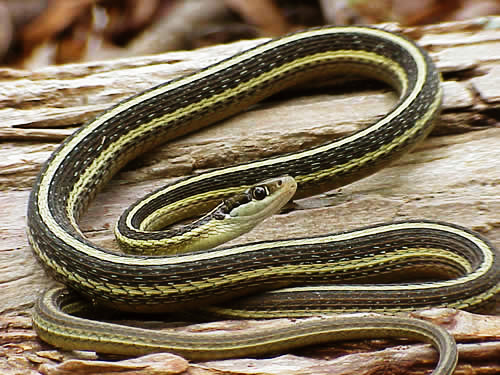
Scientific name: Thamnophis sauritus sauritus.
Common name: eastern ribbon snake, common ribbon snake.
Length: 16 – 35 in (41 – 89 cm)
Venomous: No.
Eastern ribbon snakes are slender snakes that have three yellow stripes, one down the center of the body and two down the sides with a dark background.
They can grow up to 35 inches and have no patterns on their lip scales, which helps you differentiate them against the closely related eastern garter snake.
They are observed in the Coastal Plain and have progressed to the mountainous areas and the coast.
They are semi-aquatic and often seen on the edge of salt marshes, lakes, and bogs.
40. Eastern Garter Snake

Scientific name: Thamnophis sirtalis sirtalis.
Common name: Eastern garter snake.
Length: 18–26 in (46–66 cm)
Venomous: No.
Eastern garter snakes grow up to 26 inches with three yellow stripes that run down their body. Some have a gray to red body with a checkered pattern and light stripes.
They have a light yellow to white belly and are very similar in appearance to the eastern ribbon snake.
These snakes live in a variety of habitats from marshes and hillsides to meadows and woodlands where they prefer moist areas.
They are often found near water and in suburban areas, where they hide under logs, rocks, debris, and boards.
41. Rough Earth Snake

Scientific name: Virginia striatula.
Common name: rough earth snake.
Length: 7 – 10 in (18 – 25 cm)
Venomous: No.
The rough earth snake is a slender brown to gray snake with a pointed snout that grows to around 10 inches.
Young are darker than the adults and have a light band on their neck, which fades as they age. They have tan to white bellies.
They prefer forested habitats where there is ample ground cover, where they prefer to live underground, and are often encountered when lifting a log or debris.
42. Smooth Earth Snake

Scientific name: Virginia valeriae.
Common name: smooth earth snake.
Length: 7 – 10 in (18 – 25 cm)
Venomous: No.
These snakes are small heavy-bodied snakes that are gray to brown with a pointed snout and smooth scales.
They grow up to 10 inches (24.5cm) and have black spots on their backs and sides with a white to tan belly.
The smooth earth snake from the Coastal Plains is smaller than those from the mountainous areas.
They are common in South Carolina and are found in forested habitats where there is ample ground cover.
Further Reading:
WOW! THANKS!!